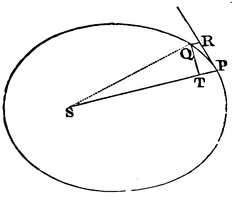
For (by Cor. 2, Prop. XIII) the latus rectum L is equal to the quantity in its ultimate state when the points P and Q coincide. But the lineola QR in a given time is as the generating centripetal force; that is (by supposition), reciprocally as SP² . And therefore is as QT² SP²; that is, the latus rectum L is in the duplicate ratio of the area QT SP. Q.E.D.
Cor. Hence the whole area of the ellipsis, and the rectangle under the axes, which is proportional to it, is in the ratio compounded of the subduplicate ratio of the latus rectum, and the ratio of the periodic time. For the whole area is as the area QT SP, described in a given time, multiplied by the periodic time.
PROPOSITION XV. THEOREM VII.
- The same things being supposed, I say, that the periodic times in ellipses are in the sesquiplicate ratio of their greater axes.
For the lesser axis is a mean proportional between the greater axis and the latus rectum; and, therefore, the rectangle under the axes is in the ratio compounded of the subduplicate ratio of the latus rectum and the sesquiplicate ratio of the greater axis. But this rectangle (by Cor. 3. Prop. XIV) is in a ratio compounded of the subduplicate ratio of the latus rectum, and the ratio of the periodic time. Subduct from both sides the subduplicate ratio of the latus rectum, and there will remain the sesquiplicate ratio of the greater axis, equal to the ratio of the periodic time. Q.E.D.
Cor. Therefore the periodic times in ellipses are the same as in circles whose diameters are equal to the greater axes of the ellipses.
PROPOSITION XVI. THEOREM VIII.
- The same things being supposed, and right lines being drawn to the bodies that shall touch the orbits, and perpendiculars being let fall on those tangents from the common focus; I say, that the velocities of the bodies are in a ratio compounded of the ratio of the perpendiculars inversely, and the subduplicate ratio of the principal latera recta directly.
From the focus S draw SY perpendicular to the tangent PR, and the velocity of the body P will be reciprocally in the subduplicate ratio of the quantity . For that velocity is as the infinitely small arc PQ described



